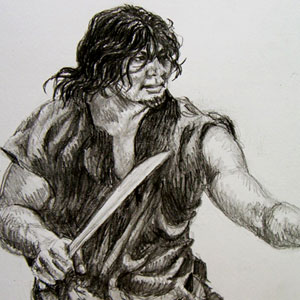Most of the engaging fight scenes in Hollywood can be found in the Bourne movie series. Jason Bourne, portrayed by Matt Damon, fends off and kills enemies in a close combat style that is very effective, offensive, explosive, and deadly. Unlike the gravity-defying stunts of other action films, this fiction series is near to reality.
Bourne movie series showcases Pekiti-Tirsia Kali (Kali), one of the oldest forms of Filipino martial arts founded in 1897. Kali is a fighting art that draws back to the Philippine cultural tradition with its history spanning 1,500 years ago. It is a weapon-based martial arts that primarily uses impact and edged weapons such as knives and sticks, where empty-handed techniques are taught after mastering the use of weapons. It is a living martial arts system that continues to evolve up to this day. While being passed from generation to generation, it is being updated to fit in the current context. All practical strokes and counter-offense movements for edged weapons are still popular today. This has also been widely employed in the military, which was also very famous in guerilla warfare and close-combat fighting.

Distinct Features
Compared to other martial arts, Kali uses a different methodology. Training begins with impact and edged weapons before doing the empty- and open-handed combat. Everyone who wants to learn Kali starts off with the proper handling of weapons. Understanding the principle of attacking is essential to let the fighter grasp the context of defense.
Douglas Marcaida II, vice president, program director for curriculum development and chief instructor for Strategic Edge Impact Global Enterprise, Inc., says Kali gives the opportunity to understand the offense mechanism before learning the defense approach. He adds that within a certain range, edged weapons pose one of the highest physical threats more than the guns. Awareness of the principle and good training on the handling of the weapons allow an individual to deal with threats and protect one’s life and other people from danger.
Multiple Strokes
Marcaida notes that Kali uses one set of body mechanics has and coupled with multiple applications, indicating that movements are the same for all weapons. Even unarmed movements use the same styles. This provides quick training if using one weapon has been mastered. Similarly, when an opponent has a weapon, it can be combated unarmed.
According to Pekiti-Tirsia Europe, Kali is a comprehensive fighting system that covers all self-protection phases. This includes awareness of within range fighting, gaps in positioning, offense and defense in armed or unarmed, single or multiple opponents and much like the instinctive fighting of Jason Bourne. It gives a sensitive attention and responsiveness with regard to oneself, the opponent and the whole environment. This type of fighting technique is dynamic, making this martial arts system one of the most dangerous but very useful in real world situations.
Expert’s Belief
Grand Tuhon Leo Gaje, Jr., the sole heir of this system from the Tortal family says, “This combat technology is more valuable than any material possession. The Kali practice sustains and preserves life itself, ensuring our personal security and prosperity, and guarantees our eternal liberty and freedom.”
What benefit does this bring to the security profession? First, it provides familiarity enabling the use of different items as weapons, both explicitly (i.e. knife) and implicitly (i.e. towel). This allows the security professional to identify all possible risks and probable weapons that can be a barrier in protecting a client. Second, it puts the situation into counter offense stance, where a threat is dealt immediately with the survival and safety of the victim are assured. Kali is proactive in nature and any client could count on Kali-trained security professionals.
Kali as a Way of Life
Police authorities worldwide recognize the tactical systems of Kali as a standard defense when dealing with edged weapons. In a training video, “Surviving Edged Weapons” with Grand Tuhon Gaje as technical advisor, law enforcement and police tactics get trained in the Filipino martial arts.
An extension of Kali is the safety baton system. Security personnel are taught how to manage the baton using the Kali movements when dealing with threats, disturbances, or riots. Dr. Kevin Parsons, executive director of the U.S. Justice System Association, commends the system and considers it as “the most dynamic, innovative and effective system in almost 20 years of police training.” •
SIDEBAR
A Way Home
A question posed by many Filipinos is eventually tied to our identity. It is a question that most of us grapple with, given a past of colonization and a present of a mishmash of cultures. It is quite amazing to know that there are people who can actually answer this question completely and definitively.
I met a man named Douglas ’Doug’ Marcaida II, vice president, program director for curriculum development and chief instructor for Strategic Edge Impact Global Enterprise, Inc., head of the Academy of Filipino Arts and founder and chief instructor for the Pekiti-Tirsia Rochester Pitbulls. With his credentials, there is no doubt he is distinguished in his craft.
When all these titles are stripped away, at heart, he is a Filipino martial arts warrior. How did he become a warrior? This began years after he had migrated from the Philippines to the United States. During his military days, he met a fellow soldier who was trained in a martial arts system. Being trained in an Asian martial arts himself, he sparred with this guy, confident that he could win.
During sparring, the moves he made proved futile as he found this man moving offensively and ingeniously. Blocks were countered with swift movements, disabling what he could give. After losing the game, he learned that the guy played Kali, a Filipino martial arts, which Doug knew nothing about. He was surprised to admit that the least.
Eager to Learn
Doug saw Kali as a practical fighting style that worked well in combat situations. He was in awe of its survival system that is proactive, offensive, and out-of-the–box approach. More important to him, it has a Filipino origin, something he could be proud of. Over the years, he became skilled at it, earning the high rank of Mandala as awarded by the Supreme Grandmaster of the system, Grand Tuhon.
When engaged in Kali movements, Doug gets to express his passion for life, where dance and play merge into one, and freedom and expression is tantamount to winning. In the world of Kali, he gets to experience who he is. For him, Kali provides an opportunity to engage the whole self without any restrictions. He notes that a man who has migrated to the other side of the world and suddenly finds himself surprised by his own culture, Kali embodies what our ancestors stand for—proud, capable, and strong. •






